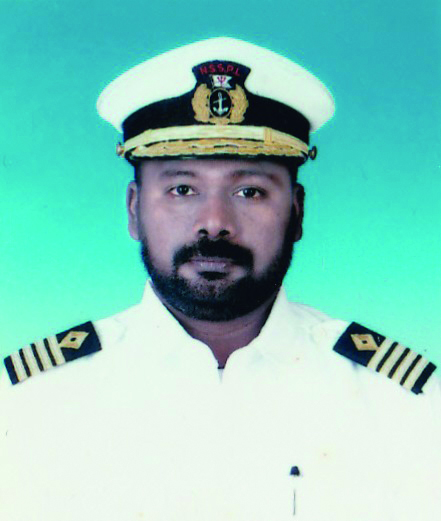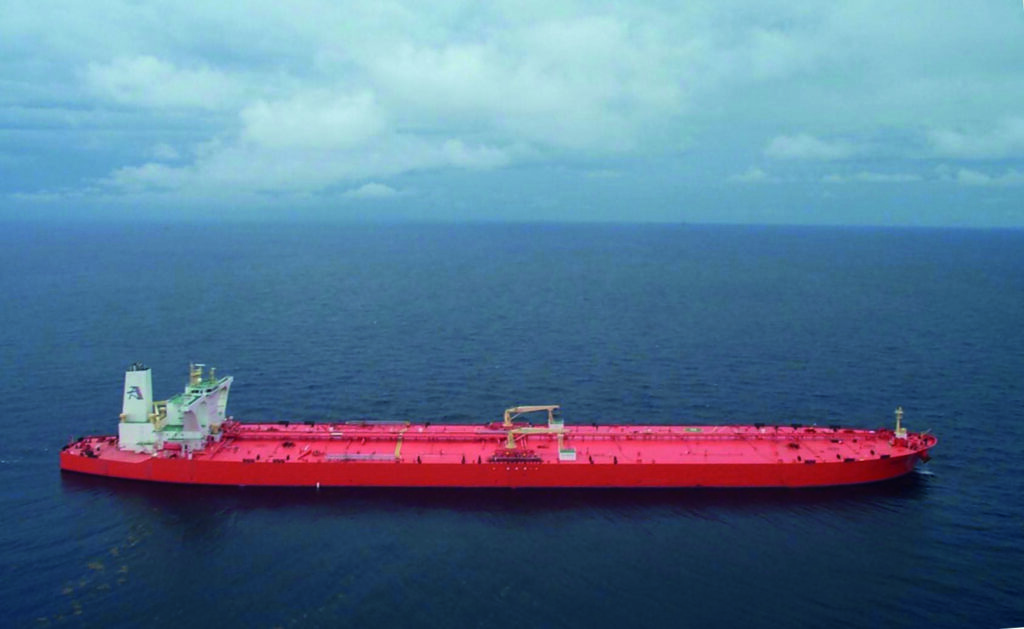Moving Energy Forward
Insights

Moving Energy Forward

As the Category 3 hurricane—with winds up to 115 miles an hour (185 km/h)—bore down on the Motor Tanker Eagle Subaru, Captain Siva Mani Raaj had to make a decision: go out to high seas or go up the Mississippi River to the discharge port at Baton Rouge.
The rapidly strengthening storm, which had been named “Tropical Storm Katrina” days earlier, offered little time for decision-making, and Capt. Mani had aboard 30 souls, property, and 600,000 bbls of crude oil, all of which needed to be protected.
This was Captain Mani’s first voyage as a captain. It would also be his first test.
The Eagle Subaru loaded the Olmeca crude from Coatzacoalcos, Mexico for ExxonMobil. It was destined for the Baton Rouge refinery. After spending a day managing a repair, the vessel moved quickly to get back on course. Manoeuvring 220 n.m. up the winding river against the current would take about 30 hours.
But on lifting anchor around midnight, Capt. Mani received a call from the Agent notifying him that a hurricane was moving towards New Orleans. He asked if Capt. Mani sought to in-bound to Baton Rouge or out-bound to the Gulf. The Agent added: “If I were you, I would sail out to sea.”
Reflecting on the situation later, Capt. Mani, who today is Global Head of Shipping Operations for Clearlake Shipping, a Gunvor subsidiary, said: “I discussed the matter with the Company Security Officer, and they gave me 50 reasons to go out to open sea and 50 reasons to go up river to the discharge port. In effect, any calculation came out the same.”
The general rules for vessels needing shelter from a storm are: if you’re at berth, proceed to anchor; if you’re at anchor, proceed to open sea; if you’re in a river, exit the river. The Eagle Subaru was located at the exact intersection of these points, where 1.4 million bbls of crude oil and oil products transit every day, crossing the Mississippi River at New Orleans.
“It could go either way,” said Capt. Mani. “But I realized there was also another option, so you could say my decision was kind of outside the box.”
What kept coming back to him were the words of the previous Master who a week earlier in Houston had handed Capt. Mani command of the vessel: “When you make a decision you have to be brave, there is ultimately no one to ask. All decisions are yours and yours alone.”
No one, however, could have foreseen that Capt. Mani’s first decision as a Captain would be how best to safeguard a fully-laden crude vessel through one of the most infamous natural disasters in American history.
“On top of everything, we had aboard the wife and daughter of the First Mate,” Capt. Mani explained, noting that it is common for Senior Officers to be allowed to have family with them.
“Although typically I would never speak with such guests about our plans, in this situation I made sure that when I addressed the crew the First Mate’s wife and daughter were fully informed,” Capt. Mani said. “The option existed for them to disembark at Baton Rouge. But I knew that given the storm’s profile it would be safer for everyone to be on the ship. A crude vessel is a floating city, with our own food, water and electricity. I made sure they understood that we would keep them safe.”
Despite making a second landfall on August 27 (after first cutting a path across Florida), something which usually weakens tropical storms, Hurricane Katrina moved back into the warm waters of the Gulf and continued to intensify throughout the day.
Captain Mani had to move.
He decided to go up river. He knew it well, having steamed up and down it for the last 15 years. Capt. Mani reasoned: “The forests along the river bank would provide a windbreak, and if the vessel did ground it would be on the riverbed made up of the soft mud of the dredged channel. Out at open sea, in the Gulf Coast, there were many oil rigs, which present considerable danger when steaming through them. If the ship lost power in hurricane force winds, it would drift towards the rigs, possibly damaging the rigs or subsea pipeline connection.”
Just after midnight on August 28, Katrina reached Category 4 intensity with 145 mph (233 km/h) winds. Six hours later, it became Category 5, with maximum sustained winds of 175 mph (282 km/h), gusts up to 190 mph (310 km/h), and a central pressure of 902 mbar, making it the strongest hurricane to approach the United States in almost 50 years. The entire Gulf coast was on high alert, and states of emergency were being ordered in several areas.
Between 0300 hrs and 0500 hrs, Captain Mani manoeuvred Eagle Subaru up the river, racing the storm to find a safe location.
“Along the way, we crossed paths with numerous people who assisted us and sought to confirm my decision. We were the only big crude vessel in the river, and everyone we encountered tried to be helpful,” Capt. Mani said. The Agent was also very helpful providing information by mobile phone, while land-based communication still operated. “However, the Coast Guard did insist on indemnity from accident.”
“From New Orleans to Baton Rouge the vessel was piloted by an old river pilot, who shared with me tales of the last major hurricanes,” Capt. Mani related. (Along the Mississippi, when a foreign ship enters state waters, a pilot boards the vessel in an advisory capacity to the captain regarding what course and speed to take. Pilots do not physically steer ships, though they have primary control of the navigation of the vessel.) “The old pilot spoke of the last two to directly hit the region: Hurricane Betsy (1965) and Hurricane Camille (1969). Camille also was a Category 5,” Capt. Mani said.
“I’ll never forget his words: ‘Back then there were bodies in the water.’ He predicted Katrina would be worse. Really, I couldn’t wait for him to get off our boat when we arrived at Port Allen. The old salt was scaring everyone. Sadly, he turned out to be right.”
Port Allen is right opposite the ExxonMobil refinery, the Baton Rouge Pilot office and the town itself. “The refinery manager promised two tugs on standby at all times. So we tied up to a general cargo ship wooden dock. The depth at this channel was 38 feet, and the Eagle Subaru had a draft of 36 feet,” Capt. Mani said.
On arrival, the crew got to work.
Capt. Mani ordered ballast water to be taken on to lower the vessel to one foot off the bottom. In case the mooring broke, the vessel could ground before it swung away from the channel. All lines available on board were used to moor the Eagle Subaru to prevent even the slightest movement against the sides, and two tug boats stood off the bow, keeping it close to berth.
The Chief Officer and crew had a long day securing the extra moorings, fitting fenders to protect against drifting vessels, and rigging cargo nets to rescue people from river. None of the crew had ever done this before. When preparations were complete, Capt Mani was sure in his heart nothing more that could be done.
With the Eagle Subaru secured, Captain Mani tried to get some sleep.
“By 0600 hrs, I was already up to the bridge communicating with both of the Tug Boat Masters “Angus R Cooper” and “J Smith” to ensure all was in order,” Capt. Mani said. “I was standing right in front of the compass on the Navigation Bridge and looking up at the Anemometer.”
At 1100 hrs, August 28, Hurricane Katrina’s eye came ashore near the Louisiana-Mississippi border, with winds of about 125 mph (200 kph). Katrina’s front-right quadrant, where a hurricane has its strongest winds and peak storm surge, slammed into Biloxi and Gulfport, Mississippi.
Hurricane Katrina struck New Orleans early in the morning on Monday, August 29.
Approximate 140 miles away, Captain Mani recalls being at the helm of Eagle Subaru when Katrina struck. “The wind gauge registered 30 mph (48 km/h), and within 30 minutes went up to 100 mph (160 km/h), where it hovered for just over 10 minutes. The wind speed fell back gradually, and that was the worst of it.”
Captain Mani’s plan worked. But his job wasn’t done.
While the Eagle Subaru was able to discharge its cargo, the vessel was stuck. Many barges had sunk in the river during the storm, closing it for navigation, and Eagle Subaru couldn’t sail out to sea. The best it could do was shift anchor to Baton Rouge, where fresh water and provisions were available. “Given the uncertainty of the situation, the cook was still ordered to ration food.”
All around the Eagle Subaru, the situation in the aftermath of Hurricane Katrina continued to worsen—including at the ExxonMobil refinery, which was running out of crude oil to process. The products would be crucial to sustaining rescue and recovery efforts along the coast.
After some “creative thinking” by those involved, Capt. Mani received a call to perform a consecutive voyage to load U.S. reserve barrels in St. James and discharge back in Baton Rouge. Although it sounded simple, it was a domestic voyage—prohibited by U.S. law. (The “Jones Act” requires that vessels transporting cargo between two U.S. ports be built in the U.S., crewed by U.S. citizens, and at least 75% owned by U.S. citizens. The Eagle Subaru did not comply.) However, a waiver was soon granted, since it was the only vessel still afloat in the river.
In the midst of the disaster, Capt. Mani led the Eagle Subaru to perform two loads over 10 days, after which the U.S. Coast Guard declared the river safe for navigation—just in time, as food, water and provisions were running low.
“When I ‘signed off’ from Eagle Subaru and went back to the office, my superior declared ‘Captain Mani, you have been baptised by Hurricane Katherina as a Master!’ It is experience I carry to work with me every day.”

Captain Siva Mani Raaj
After the Eagle Subaru, Capt. Mani served on several vessels. His last command was on MT Eagle Virginia, before switching to a shore-based job with AET Tankers in 2007. He joined Clearlake Shipping, based in Singapore in December 2011, and was promoted to Global Head of Operations for Clearlake Shipping in October 2013, a position he holds today.

Voyage Details
Vessel : Motor Tanker Eagle Subaru
Gross Tonnage: 52,504
Call Sign: “S6FP”
Flag: Singapore (SG)
Cargo: 600,000 Bbl Olmeca Crude
Origin: Coatzacoalcos, Mexico
Destination: Baton Rouge, Louisiana
Cargo Owner: ExxonMobil
UNITED STATES CONGRESSIONAL RECORD
“At ExxonMobil’s Baton Rouge refinery, managers relied on creativity and improvisation to keep the facility functioning during and after Katrina. For example, loss of electric power shut off imports, particularly those coming through the Louisiana Offshore Oil Port (LOOP), which are vital to the refinery. As a stopgap, company officials located a foreign tanker full of oil that had ridden out the storm south of Baton Rouge and brought it to the refinery―after quickly obtaining a waiver from the Jones Act that prohibits a foreign-flagged vessel from traveling between two U.S. ports.”